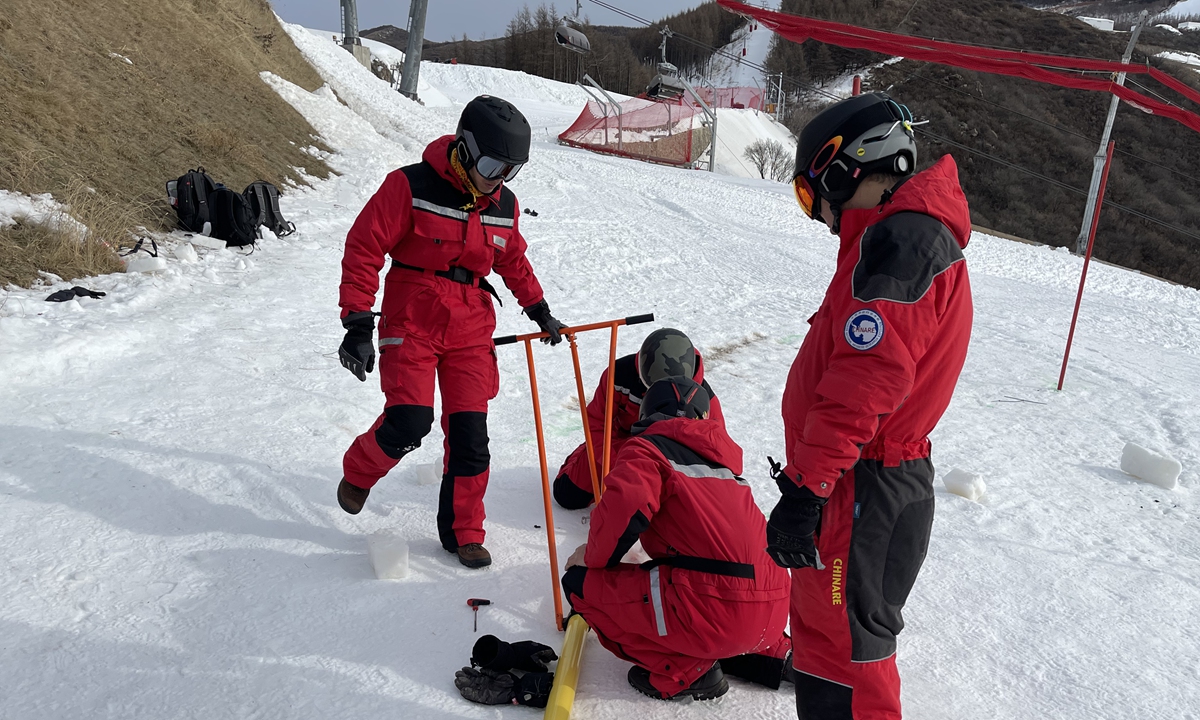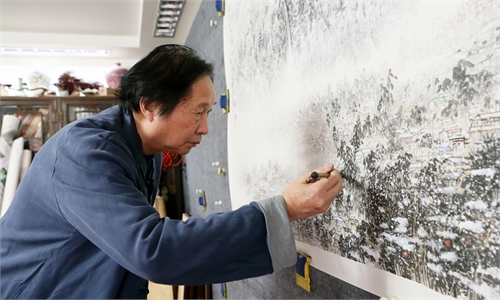Exclusive: How China developed snow-making technology for Beijing 2022 amid complex climate conditions

The research team conducts an icy snow production experiment at the National Alpine Skiing Centre in Beijing in December 2021. Photo: Courtesy of Wang Feiteng
A group of Chinese experts, after years of research and testing, developed localized artificial snow technology for the Beijing Winter Olympic Games that is able to adapt to Beijing's dry climate, which features big swings in temperatures between day and night.
The success breaks the key snow-making technology blockade and paves the way for the development of China's winter sports in the post-Olympics era.
Wang Feiteng, a professor at Northwest Institute of Eco-Environment and Resources of the Chinese Academy of Sciences and a member of the snow-making expert team for Beijing 2022, has been working to provide technical support and services for the Games in terms of snow making, storage, quality guarantees and track maintenance since the Games have started.
"At venues such as Big Air Shougang and the National Ski Jumping Center, we stored artificial snow in preparation for extreme weather conditions including temperature increases and sandstorms," Wang told the Global Times in an exclusive interview on Tuesday.
The expert noted that the Paralympic Winter Games, which will be held in March, will increase the difficulty and risk of the work due to rising temperatures.
Though the artificial snow is being used for Beijing 2022, a few years ago China had barely any experience in making artificial snow or providing the snow services needed for the Games.
In 2017, China established its own key technology team for the event.
Wang and other team members conducted many field experiments and obtained key techniques for an optimal water injection compaction program under different weather conditions for making icy snow.
Wang explained the complexity of making snow for different venues as different competitions require unique snow textures. The most difficult one was to make icy snow for the National Alpine Ski Centre, located in Beijing's Yanqing District, the first Olympic-standard alpine ski venue in China with a maximum vertical drop of about 900 meters.
Making icy snow is a core task for alpine skiing courses because competitors can reach top speeds of 130 to 140 kilometers per hour.
Wang said that common snow machines can only make snow with densities of around 0.3 and 0.4 grams per cubic centimeter, but the density of icy snow needs to be 0.65 grams per cubic centimeter.
To improve the density of the snow requires lots of precise parameters such as how often the water needs to be filled and how much water pressure is needed in the snow production process, he said.
After three years of experiments at different ski resorts including the one in Yanqing, the team developed a localized snow production and service technology that is suitable to China's climate. The icy snow gained praise from international delegations and Olympians.
Chairman of the Alpine ski committee of the International Ski Federation Bernhard Russi said on February 5 that the snow in the Yanqing National Alpine Skiing Center is "absolutely perfect, and you cannot have it better," the Xinhua News Agency reported.
US skier Ryan Cochran-Siegle also spoke highly of the snow conditions at China's National Alpine Ski Center. In an Instagram post on January 30, Cochran-Siegle said that "spectacular snow and tantalizing terrain should make for some amazing race conditions!"
In the comments section, he replied to a netizen who asked whether the snow was artificial, saying that most of it was, but that's "pretty much no different than any other venue we ski at."
When international athletes praised the artificial snow at the venues, some Western media claimed that the snow was "environmentally unfriendly" especially considering Beijing's strained water resources.
Reuters quoted a professor saying Beijing was the "worst of all candidates, because it required so much more water."
In response, Wang said those critics had no basic knowledge of the Games, as natural snow with a very low density cannot be used for competitions.
"Beijing and Zhangjiakou witnessed snowfall last week, but what the organizers did in the first place was to remove the natural snow," Wang said.
About 80 percent of the snow used in the Sochi Winter Olympic Games in 2014 was artificial, and the number was 98 percent for the PyeongChang Games in South Korea in 2018, Time Magazine reported.
During the Vancouver Games in 2010, organizers had to deploy helicopters, trucks and snow machines to transport snow to venues as temperatures rose.
The water needed for the Beijing 2022 games was mainly collected from rainfall and surface runoff, which doesn't affect underground water resources.
Wei Qinghua, operation manager at Zhangjiakou competition zone's Guyangshu Cluster operation, told the Shanghai-based Xinmin Evening News that the water resources needed for making snow in the venues in Zhangjiakou came mainly from rainfall and surface runoff, and after the Olympics, the snow will melt and the water will be stored in local reservoirs for irrigation in non-snow seasons.
Other ski resorts in China have adopted the same technique. Wang said that a demonstration project set in Maoer Mountain Ski Resort in Harbin, Northeast China's Heilongjiang Province, has balanced water resources as the resort collects rainfall, then uses it in the winter to make snow, and stores the water again after the snow melts.
Some media said the artificial snow was heavier than natural snow and that may affect the growth of plants underneath, Wang said that the artificial snow has very little impact on soil or plants. Snow for normal ski resorts is about 50 to 60 centimeters thick, and at the Games it may reach 1 meter, which would not be heavy enough to affect plants.




